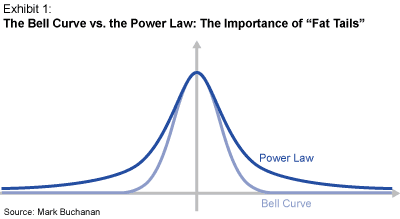Look at the diagram below from [3] (also a great overview of power laws). As you can see, a bell curve will predict that unlikely events are very rare. In cases of independence of phenomena that is likely. A power law distribution looks similar, but has a "fat tail". The implication is that it predicts that rare events are much more likely (you may say that the interdependence creates a possible "butterfly effect").

An example from [2] (a brilliant book by the way) is illustrative. In the book business, the largest brick and mortar shops can keep an inventory of maximum 100.000 books. After that the business of keeping them in store becomes unprofitable. A site like Amazon.com has an inventory of over 1.5 million books and growing. Even though it sells only a a few copies of the millionth popular book, it still makes a profit on it. That's due to the low costs of storage, distribution and sales.
An example from [3] is another illustration : "In the case of market fluctuations, for example, the bell curve predicts a one-day drop of 10 percent in the valuation of a stock just about once every 500 years. The empirical power law gives a very different and more reliable estimate: about once every five years." As the reader may know, we see 10 percent drops fairly often!
[1] Wikipedia - Power Law
[2] The Long tail
[3] Power Laws & the New Science of Complexity Management
No comments:
Post a Comment